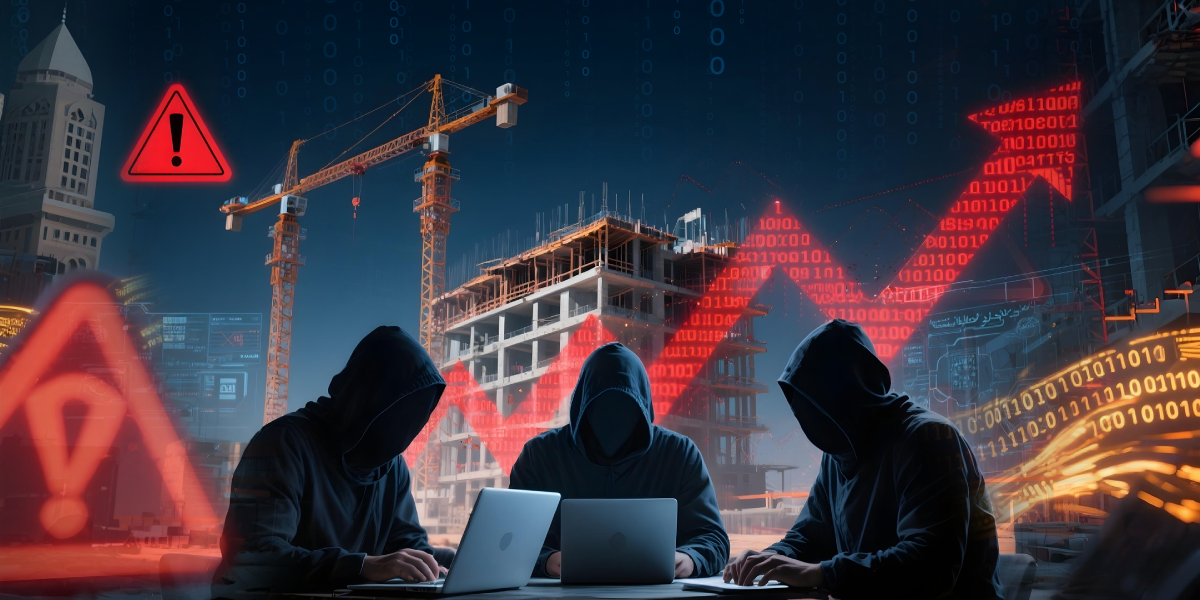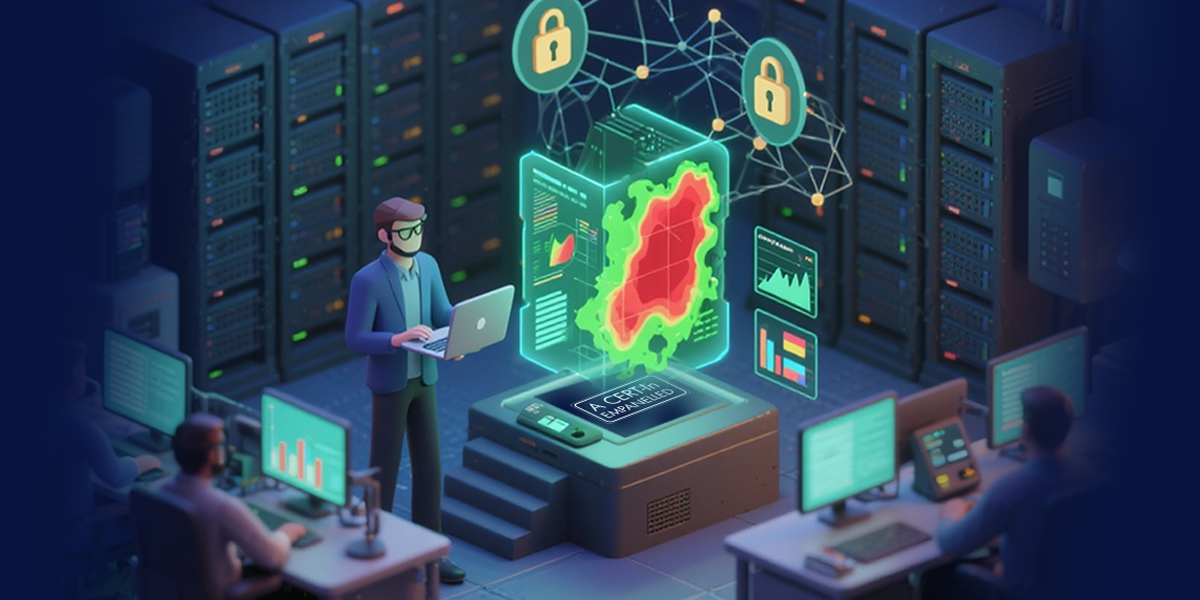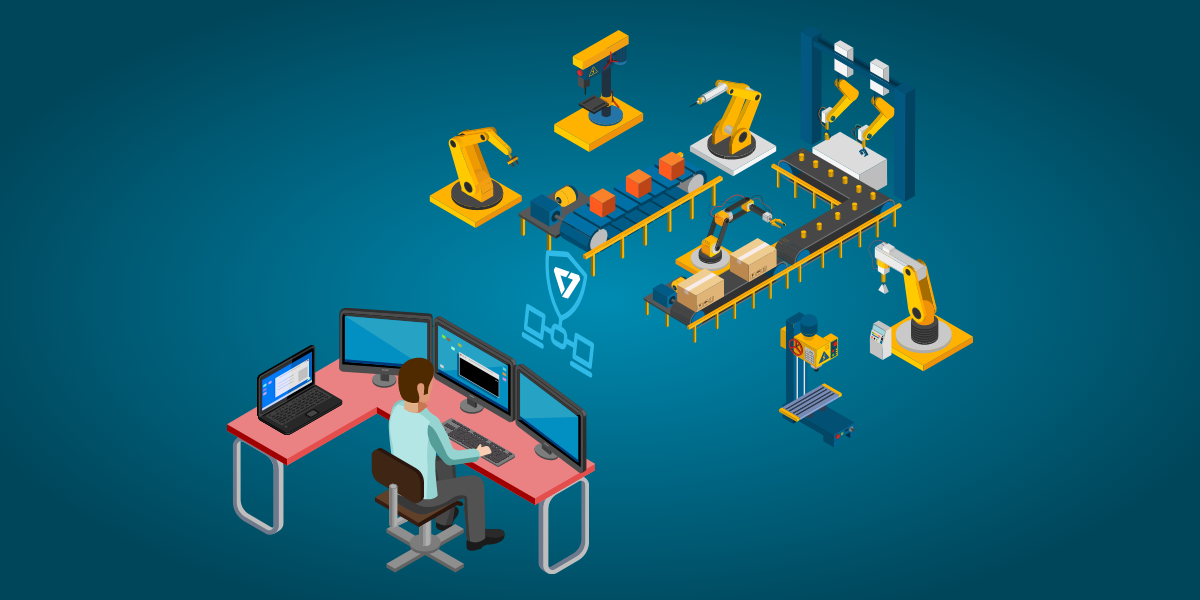The Middle East, a region synonymous with audacious development, sees its skyline continually redefined by architectural marvels and smart city initiatives. This relentless pursuit of digital transformation, while undeniably fueling economic diversification, also carves out a new, precarious battleground: the cyber domain. While critical sectors like finance and energy have long been on high alert, the construction industry, once considered a “low-tech” sector, has quietly emerged as a prime target, making this a pivotal moment for every business across the region.
This isn’t merely about data breaches; it’s about the very digital underpinnings of the Middle East’s ambitious future facing a relentless siege. This exposé aims to sound an urgent alarm for the construction sector, dissecting the escalating threats and their underlying causes while simultaneously elevating cybersecurity awareness for all enterprises navigating this perilous, evolving landscape.
Why Construction Has Become the New Cyber Battlefield
The perception of construction as a low-tech domain is dangerously outmoded. Today, it’s a dynamic hub of digital innovation, yet its cybersecurity posture often trails significantly behind, creating a perfect storm for cyber adversaries.
- Low Cybersecurity Maturity: Many construction firms, particularly small to medium-sized enterprises (SMEs), which form the backbone of the supply chain, suffer from a history of underinvestment in cybersecurity. They often lack dedicated security teams, robust incident response plans, and even fundamental security protocols, making them attractive, low-hanging fruit for attackers.
- High-Value Assets & Payments: Construction projects involve staggering sums, from initial bids to multi-stage payments and complex financial flows. These immense transactions are a magnet for financial criminals, making firms highly susceptible to Business Email Compromise (BEC) and sophisticated wire fraud.
- Complex Supply Chains & Third-Party Reliance: A single project weaves an intricate web of architects, engineers, subcontractors, specialized vendors, and cloud service providers. This extensive third-party reliance means that a security weakness in any single partner can become a direct gateway for attackers to compromise the entire project ecosystem. Every connection is a potential weak link.
- Sensitive Data & Intellectual Property: Construction businesses are veritable treasure troves of highly sensitive and valuable data. This includes detailed blueprints, Building Information Modeling (BIM) models, critical infrastructure designs, proprietary building techniques, financial records, employee data, and strategic project timelines. This information is gold, not just for financially motivated criminals seeking extortion leverage, but also for nation-state actors engaged in espionage or sabotage.
- Operational Downtime & Project Penalties: The construction industry operates on unforgiving deadlines. Delays due to cyberattacks can trigger crippling financial penalties, liquidated damages, and severe reputational fallout.Attackers, particularly ransomware gangs, exploit this immense pressure, knowing firms are often compelled to pay ransoms swiftly to restore operations and avert spiraling costs.
- Digital Transformation & Expanding Attack Surface: The sector’s embrace of digital tools, cloud-based project management platforms, remote collaboration tools, drones, and IoT sensors on construction sites, while boosting efficiency, has dramatically expanded the attack surface. Many of these new technologies, or the legacy systems they connect to, are implemented without adequate security considerations, creating fresh vulnerabilities. As of Q1 2025, rapid digitalization has left many firms reliant on unpatched third-party platforms and IoT devices, extending their digital footprint.
The Threat Actors: Who’s Behind the Construction Onslaught?
The rising tide of cyberattacks on the Middle East’s construction sector isn’t the work of a single entity. It’s a multi-pronged assault from diverse, sophisticated actors, each with distinct motivations and increasingly blurred methodologies.
1. Organized Cybercrime / Ransomware Gangs
These groups are primarily driven by financial gain, often leveraging Ransomware-as-a-Service (RaaS) models, where sophisticated tools are leased to affiliates who execute the attacks. However, their operations can also align with broader geopolitical destabilization by causing economic chaos.
-
- Prominent Actors: LockBit (globally prolific), RansomHub, PLAY, 8Base, Akira, and Qilin remain highly active. Newer, agile groups like FunkSec (using AI-enhanced malware) and Lynx (a scalable RaaS platform) have also emerged, specifically targeting industrial and construction spaces.
- Their Playbook (Common Attack Methods):
-
- Initial Access: They often gain their initial foothold through highly customized phishing and spear-phishing campaigns, impersonating legitimate contacts or leveraging enticing lures. Business Email Compromise (BEC) is a prevalent scam, often targeting finance departments. They also exploit unpatched vulnerabilities in public-facing services like RDP, VPNs (e.g., Ivanti, Fortinet), and Microsoft Exchange servers, or purchase initial access from dark web brokers.
- Lateral Movement: Once inside, they move stealthily through the network, often “living off the land” by exploiting legitimate tools (LOLBins, such as PowerShell, PsExec, and WMIC). They exploit Active Directory weaknesses and insecure configurations to escalate privileges and gain control over critical systems.
- Payload Deployment: After establishing control and exfiltrating data (for double extortion), they deploy their ransomware to encrypt critical files and systems, crippling operations. Some variants may even include data wiping capabilities for maximum disruption.
2. Nation-State Advanced Persistent Threat (APT) Groups
These sophisticated, state-backed actors are motivated by espionage (economic, political), sabotage, and intellectual property theft, often to gain a strategic advantage in the geopolitical arena. Their attacks are highly targeted, persistent, and designed for long-term presence.
- General Activity in the Middle East: APTs linked to Iran, China, and Russia are consistently active in the Middle East. While specific confirmed attacks on construction firms by these groups are often kept under wraps due to their covert nature, their broader TTPs and motivations clearly indicate a keen interest in this sector.
- Iranian APTs (e.g., MuddyWater): Have demonstrably broadened their focus beyond government entities to include construction and industrial targets as part of larger regional cyber-espionage and disruptive campaigns. They seek intelligence on critical infrastructure, energy projects, and strategic developments.
- Chinese APTs: Notorious for widespread intellectual property theft across various industries, including those related to critical infrastructure development and advanced materials. They would naturally be interested in blueprints, BIM data, and innovative construction techniques.
- Russian APTs: While often associated with political espionage and critical infrastructure attacks, they may target construction firms involved in sensitive government projects or those building critical national infrastructure for reconnaissance or pre-positioning.
- Sophistication: These groups utilize custom malware, leverage zero-day exploits (previously unknown vulnerabilities), and employ highly evasive techniques to maintain long-term persistence and blend seamlessly into network traffic.
 Handala: The Geopolitical Game-Changer in Construction
Handala: The Geopolitical Game-Changer in Construction
A particularly concerning development for the Middle East construction sector is the evolution of Handala. Originally known as a pro-Palestinian hacktivist collective, Handala has significantly upped its game, blending its hacktivist ideology with professional ransomware operations and data extortion tactics.
- Geopolitical Motivation: Handala’s attacks are explicitly driven by geopolitical objectives. They target organizations perceived as linked to or supporting Israeli strategic interests, or those involved in critical infrastructure projects in rival nations.
- Recent Activity: In June 2025, Handala notably claimed responsibility for a significant breach targeting Israeli construction company Zacharia Levi Ltd. They are alleged to have exfiltrated the company’s entire database, including project files, contracts, financial documents, internal communications, and technical blueprints. The subsequent leak of over 20GB of data served as proof of compromise, inflicting severe reputational and business damage.
- Why Construction? For groups like Handala, a construction firm isn’t just a financial target; it holds strategic and symbolic value. Access to critical infrastructure blueprints (e.g., airports, oil terminals, military bases) can be leveraged for intelligence, disruption, or to make a powerful political statement. The very foundations of a nation’s development become a weapon. Handala’s techniques include spear-phishing, credential harvesting, privilege escalation, and using legitimate cloud storage services as C2 (Command and Control) and exfiltration surfaces. They stage leaks to maximize psychological and economic impact, often coinciding with physical events or political escalations.
3. Insider Threats
While less sensational, the risk posed by insiders remains constant. Whether it’s a disgruntled employee seeking revenge, a staff member bribed by an external actor, or simply careless staff falling victim to social engineering, insiders can provide direct access to sensitive data and systems, leading to data theft or sabotage.
Why the Middle East Construction is a Hotbed for Cyber Threats
The surge in cyberattacks isn’t isolated to construction; it’s a symptom of broader trends making the entire Middle East a compelling target for cyber adversaries.
- Geopolitical Tensions: The inherent instability and conflicts within the Middle East directly fuel state-sponsored cyber warfare and hacktivist campaigns. Cyber operations become extensions of geopolitical rivalries, leading to a constant state of heightened alert. As of 2025, the region has been a focal point for cyber conflict, with activity escalating amid regional tensions.
- Rapid Digitalization: The region’s ambitious visions for smart cities (e.g., NEOM, Dubai’s AI push), advanced industrialization, and accelerated adoption of cloud services mean an ever-expanding attack surface. New digital infrastructure, while transformative, often presents new vulnerabilities if security isn’t built in from the ground up.
- Valuable Economic Assets: The Middle East holds critical global economic assets in oil & gas, finance, logistics, and burgeoning tech sectors. These high-value targets are irresistible to financially motivated criminals and nation-states seeking economic advantage or disruption.
- Lagging Cybersecurity Postures: While awareness is growing, many enterprises across the Middle East still face a general lag in cybersecurity maturity compared to leading global regions. This often includes insufficient budgets, outdated security infrastructure, and a reactive rather than proactive approach to threats.
- Shortage of Skilled Professionals: The cybersecurity talent gap is a global challenge, but it’s particularly acute in the Middle East. This shortage makes it harder for enterprises to recruit, retain, and adequately train the skilled professionals needed to defend against sophisticated threats. A PWC report in 2025 noted that over 50% of Middle East organizations faced challenges in retaining top cybersecurity talent.
Read More: The Luxury Cybersecurity Crisis: Safeguarding Supply Chains From Ransomware
Actionable Strategies for Protection: Building Cyber Resilience
The rising tide lifts all boats, but also exposes all vulnerabilities. For all enterprises in the Middle East, and especially those in the construction sector, proactive measures are no longer optional—they are imperative for survival and sustained growth.
- Adopt Robust Cybersecurity Frameworks: Don’t reinvent the wheel. Implement globally recognized frameworks like NIST Cybersecurity Framework, ISO 27001, or Saudi Arabia’s NCA Essential Cybersecurity Controls (ECC). These provide a structured approach to identifying, protecting, detecting, responding to, and recovering from cyber incidents.
- Enforce Stronger Access Controls & Multi-Factor Authentication (MFA): This is foundational. Implement MFA for all user accounts, especially for remote access, cloud services, and privileged accounts. Regularly audit and limit administrative privileges to only what’s absolutely necessary. Credential exposure is rapidly increasing, fueling numerous attacks, with 75% of digital risk alerts tied to stolen login credentials on the dark web.
- Proactive Vulnerability Management & Patching: Cybercriminals and APTs thrive on known vulnerabilities. Establish a rigorous program for identifying, assessing, and rapidly patching software, operating systems, and network devices. This includes IT, IoT, and operational technology (OT) systems used on construction sites.
- Mandatory Employee Security Awareness Training: Your employees are your first line of defense. Conduct regular, engaging, and practical training on phishing, social engineering, safe browsing habits, and data handling. For construction, tailor training to specific project management software and site-based technologies. Initial access is often gained through targeted phishing campaigns that exploit a lack of user awareness.
- Comprehensive Supply Chain Risk Management: Given the intricate nature of construction projects, vet all third-party vendors and partners rigorously. Implement strong security clauses in contracts, conduct regular security assessments of suppliers, and monitor their security posture. Assume your partners can be compromised.
- Develop & Test a Robust Incident Response Plan: It’s not a matter of if you’ll be attacked, but when. Develop a clear, actionable incident response plan that outlines roles, responsibilities, communication protocols, and steps for containment, eradication, and recovery. Regularly test this plan through tabletop exercises to ensure readiness and preparedness.
- Implement a Resilient Backup & Recovery Strategy: This is your last line of defense against ransomware. Ensure you have immutable, air-gapped, and regularly tested backups of all critical data and systems. These backups should be isolated from your primary network to prevent encryption by attackers.
- Network Segmentation & Isolation: For large enterprises, particularly those with OT/ICS environments (common in smart building projects or industrial construction), segment your networks. Isolate critical operational technology (OT) systems from your corporate IT network to prevent lateral movement of threats from IT to sensitive control systems.
- Engage in Threat Intelligence Sharing: Collaborate with industry peers, regional cybersecurity centers, and specialized security firms to share threat intelligence. Understanding the latest tactics, techniques, and procedures (TTPs) of threat actors targeting your sector and region can significantly enhance your defensive posture.
- Invest in Advanced Security Tools: Beyond basic antivirus, deploy Endpoint Detection and Response (EDR) or Extended Detection and Response (XDR) solutions, Security Information and Event Management (SIEM) systems for centralized logging and anomaly detection, and advanced email security gateways to combat sophisticated phishing.
Read More: Why Every Business Needs An Incident Response Plan
Conclusion: Build Resilience, Not Just Structures
The cybersecurity landscape in the Middle East has been irrevocably altered. For the construction sector, the era of being an overlooked target is definitively over. You are now on the digital front lines, facing sophisticated criminal enterprises and ideologically driven nation-state actors. Your blueprints, your financial transactions, and your project timelines are no longer just business assets; they are strategic objectives for adversaries.
For all enterprises across the Middle East, this escalation in the construction sector serves as a stark warning. The interconnectedness of our digital world means a weakness in one industry can send ripple effects across the entire economic ecosystem. Cybersecurity is no longer just an IT department concern; it is a fundamental business imperative, a core component of risk management, and a critical element of national and regional security.
The time to act is unequivocally now. Invest in your cyber defenses, empower your teams, secure your supply chains, and cultivate a culture of unwavering vigilance. By doing so, you’re not merely protecting your business; you’re contributing to the collective cyber resilience that will truly safeguard the Middle East’s ambitious future.











